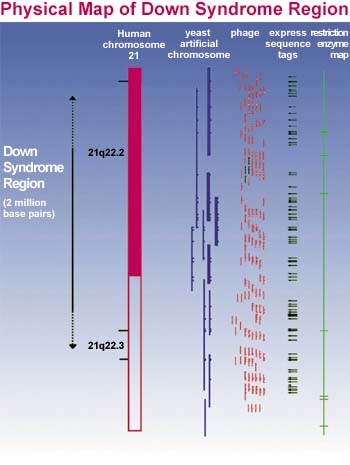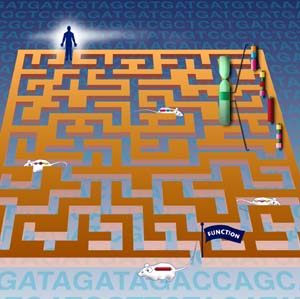 orking with transgenic mice that carry segments of human chromosome 21 in their DNA, Berkeley Lab geneticists were able to identify a gene responsible for mental retardation in Down syndrome. Learning deficits have been positively linked to DYRK, a gene named for the protein it produces. Any deviation from the normal complement of two copies of this gene has been shown to impair the ability to learn.
orking with transgenic mice that carry segments of human chromosome 21 in their DNA, Berkeley Lab geneticists were able to identify a gene responsible for mental retardation in Down syndrome. Learning deficits have been positively linked to DYRK, a gene named for the protein it produces. Any deviation from the normal complement of two copies of this gene has been shown to impair the ability to learn.
The discovery was made by Drs. Edward Rubin and Desmond Smith and their colleagues, who created a special series of transgenic mice containing different adjacent segments of human chromosome 21. Their idea stemmed from the existence of rare forms of Down syndrome in which only part of chromosome 21 is present in triplicate. This suggested that the condition may be due to a limited number of genes.

|
(Click on image to enlarge)
|
|
This figure shows the various comparative methods used to locate a region on human Chromosome 21 associated with Down Syndrome. Rubin and his
colleagues identified a stretch of some two million base pairs that conferred the Down phenotype in mice.
|
"We've demonstrated that DYRK is a gene for which dosage plays an important role in how neuronal pathways are put together," said Rubin, when the finding was announced. "Our work suggests that you need exactly two copies of DYRK for normal development."
To identify which gene was responsible for mental retardation, Smith and Rubin assessed the learning and memory skills of their genetically altered mice using a standardized test. The mice were placed in a tank filled with opaque water and clocked for how long it took them to find their way to a platform hidden just below the water's surface.
"Our strategy made no prior assumptions about individual genes, but rather, allowed the behavior of the mice to guide us to a crucial gene on chromosome 21," Rubin said. "This approach of using the whole animal is likely to become increasingly important as geneticists attempt to investigate the basis of other complex human conditions such as hypertension or schizophrenia."
The strain of mouse that performed the most poorly on the test carried a human DYRK gene in addition to a pair of mouse DYRK genes. That the extra copy of DYRK was the culprit, the researchers said, was supported with the discovery that DYRK is almost identical to a fruit fly gene called minibrain. Fruit flies that carry only a single copy of minibrain instead of the the normal two copies also display impaired learning -- they are unable to find their way to a particular smell.
| Lead scientist on this project
|
|
|
|
|
|
"Obviously a large leap of faith must be taken to equate learning in flies to that in humans," says Rubin. "However, the corresponding findings in both flies and mice concerning the effect of an altered copy number of DYRK or minibrain support the idea that altered expression of this gene may be an important contributor to the learning defects in humans with Down syndrome."
Mice are among the best models for medical research because their physiology is so similar to that of humans. Currently, transgenic mice serve as animal models for a number of human diseases, including bone disorders and several forms of cancer.
This past year, Rubin also announced the development in his laboratory of a new strain of transgenic mouse that fully mimics all the symptoms of human sickle cell disease. With this new mouse model, medical researchers may finally have a means of effectively testing experimental treatments for a painful and debilitating condition that affects approximately one out of every 500 African-Americans in this country.
- Lynn Yarris



 orking with transgenic mice that carry segments of human chromosome 21 in their DNA, Berkeley Lab geneticists were able to identify a gene responsible for mental retardation in Down syndrome. Learning deficits have been positively linked to DYRK, a gene named for the protein it produces. Any deviation from the normal complement of two copies of this gene has been shown to impair the ability to learn.
orking with transgenic mice that carry segments of human chromosome 21 in their DNA, Berkeley Lab geneticists were able to identify a gene responsible for mental retardation in Down syndrome. Learning deficits have been positively linked to DYRK, a gene named for the protein it produces. Any deviation from the normal complement of two copies of this gene has been shown to impair the ability to learn.

